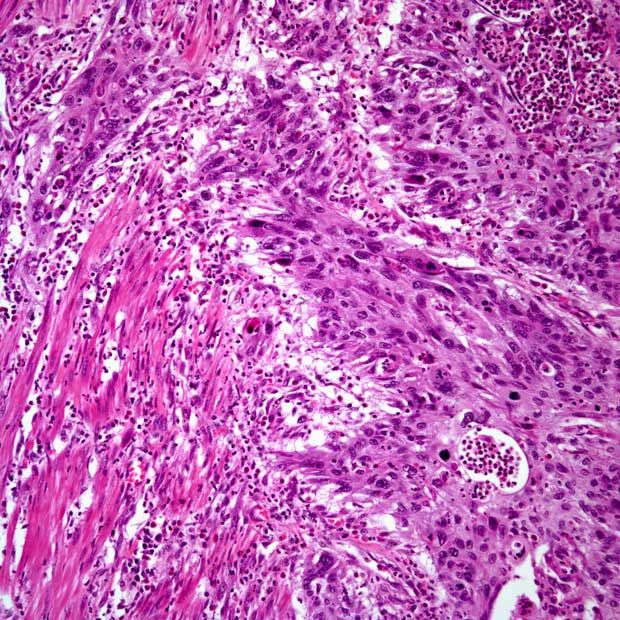Neoadjuvant Regimen Shows Efficacy in Bladder Cancer
Neoadjuvant treatment with dose-dense methotrexate, vinblastine, doxorubicin, and cisplatin was well tolerated and should be considered a reasonable option for patients with muscle-invasive urothelial cancer, according to a new study.
Infiltrating high-grade urothelial transitional cell carcinoma of the bladder; source: Cesar A. Moran, MD

Neoadjuvant treatment with dose-dense methotrexate, vinblastine, doxorubicin, and cisplatin (ddMVAC) was well tolerated and should be considered a reasonable option for patients with muscle-invasive urothelial cancer, according to the results of a study published online in the Journal of Clinical Oncology.
The ddMVAC regimen was designed to reduce toxicity and safety issues associated with the traditional MVAC regimen; ddMVAC was administered on a 2 weeks per cycle schedule with double the dose of cisplatin and doxorubicin and a reduced dose of methotrexate and vinblastine.
“There is no standard neoadjuvant therapy in muscle-invasive bladder cancer and data is mostly extrapolated from the metastatic disease, where dose-dense MVAC was found to be active and better tolerated than standard MVAC,” study author Toni K. Choueiri, MD, of Dana-Farber Cancer Institute told Cancer Network. “It is important to have data in this setting to guide therapy.”
In this study, Choueiri and colleagues treated patients with cT2-cT4, N0-1, M0 muscle-invasive urothelial cancer with ddMVAC with pegfilgrastim support. Patients underwent 4 cycles of treatment followed by radical cystectomy. The primary endpoint of the study was patient downstage to pT1, N0, M0 or better.
“We found that dose-dense MVAC is an active and tolerated regimen,” Choueiri said. “It results in almost half of the patients being downstaged to superficial disease or responding completely.”
The patients were followed for a median of 2 years. Forty-nine percent of patients achieved a pathologic response and were downstaged to pT1, N0, M0. Among those patients with pathologic response, 26% achieved complete pathologic response. Only 10% of patients experienced grade 3 or higher adverse events, with no neutropenic fever or treatment-related death.
Choueiri said that the results were not surprising given prior data in the metastatic setting; however, this study now shows activity in patients with high-risk disease.
“What is even more interesting is the rate of radiologic responses and to see this combo to be [well] tolerated,” Choueiri said. “Also, it is good to know that patients who achieve a response end up living longer; in fact, we found a meaningful association between disease-free survival and a pathologic or a radiologic response.”
Patients who achieved pathologic response had a 1-year disease-free survival of 89% compared with only 67% in patients who did not achieve a response (P = .08). Patients who achieved a radiologic response had a 1-year disease-free survival of 86% compared with 62% for patients who did not (P = .009).
Based on these results, Choueiri said that ddMVAC is a reasonable choice in muscle-invasive bladder cancer patients who can receive cisplatin, like those with good kidney function and good performance status.